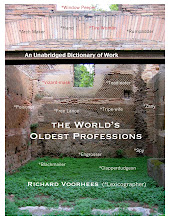A clergyman living with others in a clergy house or cathedral, who follows the canons or rules of the church.
"This practice of the canonica vita or canonical life began to prevail in the 8th century; in the 11th century it was, in some churches, reformed by the adoption of a rule (based upon a practice mentioned by St. Augustine) that clergymen so living together should renounce private property: those who embraced this rule were known as Augustinian (Augustin) or regular, the others were secular canons." (OED).
"By 1441 Gloucester's authority in the State was wellnigh ended, but some historians believe his enemies used the charge against his wife to deliver the coup de grace. As a preliminary, charges were brought against two men, Roger Bolingbroke, an Oxford priest, 'a great and cunning man in astronomy', and Thomas Southwell, canon of St. Stephen's, Westminster, who were accused of making a wax image of Henry VI, which they exposed to a slow fire, and by aid of the devil, as the image melted, so the life of the king would fade away. Bolingbroke, on a July Sunday in 1441, was placed on a high scaffold outside St. Paul's, arrayed in his magic garments. About him were the writings, the images of wax, silver and metal, together with other instruments of his craft. He had a paper crown and there before the multitude swore to abuse his false craft of the devil. From there he was taken to the Tower to await further judgment."
Six Medieval Men & Women, "Henry, Duke of Gloucester," H. S. Bennett (1955).
Saturday, November 7, 2009
Subscribe to:
Post Comments (Atom)

No comments:
Post a Comment